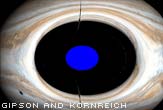Wouldn't it be interesting to stand next to a black hole, peek inside and see what it looks like?
Michal Levinstein

Researchers at Humboldt State University in California can - safely - from our computer. "The idea is to see what a black hole looks like," says David Kornreich. The simple answer is "black", because light cannot escape the gravitational pull of a black hole. But light traveling near a black hole - its path will bend, just like what happens in a lens.
Kornrich and his student - Bryant Gipson - calculated how landscape images or planets would be distorted if there was a black hole in the background. "Mathematical calculations have been done in the past for stationary black holes - this is the first time such a calculation has been made for a rotating black hole. Most of the black holes in the universe are considered to be rotating, some of them are at high speed," Kornrich says.
A stellar black hole, formed when a star dies in an explosion - the rotation is a logical consequence of the star's rotation. Just as an ice skater speeds up the spin when she folds her arms inward, the dying star's spin accelerates dramatically as it collapses into a small, compact black hole.
Reflections and horizons
The calculations for a black hole are complicated, due to the fact that the space around a black hole must rotate with it and therefore has an effect on everything that surrounds it - the Frame Dragging phenomenon.
"Rays of light will also be attracted to the rotation," says Kornrich, "and those whose direction is opposite to the direction of the rotation of the black hole sometimes do not survive - they are deflected backwards."
The thought holds that since there are rays of light deflected back in our direction - there is a possibility that the viewer will see his own reflection if he looks closely at the side of the black hole rotating in his direction. But that still doesn't mean that astronomers will be able to see themselves through the telescope... "It's something you can only see in a spacecraft when you get close to a black hole," says Kornrich.
To observe such distortions, one must be at a distance of 3-4 times the Schwarzschild radius of the black hole - for a stationary (non-rotating) black hole, the radius defines the Event Horizon - a (spherical) irreversible domain. For example - a black hole with the same mass as our Sun will have an event horizon with a radius of 3 km (2 miles). A black hole with the mass of the Earth will have an event horizon with a radius of 9 mm.
Gipson explains "A photon thrown directly from a black hole through the event horizon can escape, but if not - it will go around it or spin back or deflect".
The mass of the black hole is somewhat arbitrary. The curvature can be large and far, or small and close to the black hole. To clarify, the researchers assume that the black holes weigh about as much as the Sun and we are looking at them from a distance of 10 miles.
The naked border
Naked Limit is the theoretical limit to the rotation speed - which is, technically, the angular momentum - of the black hole. If it rotates at a speed greater than that - the event horizon will disappear and reveal the point of infinite compression - the Singularity - in the center of the black hole.
"A naked singularity is a black hole rotating at such a high speed that there are light rays that are able to escape from it in certain orbits. Therefore, an observer may see the uniqueness in the center" says Cornrich.
A body rotating at a speed higher than the naked limit will probably break into pieces even before it becomes a black hole. Therefore it is reasonable to assume that naked singularities do not exist "but it is interesting to think about them" says Cornrich.
Kornrich and Gipson presented some of their images at the American Astronomical Society meeting in May of this year. Their ultimate goal is to create an educational software package.
"The idea is to put in a computer program - not a video game, but something similar to it - that will give you the ability to walk around a black hole and get closer to it," Kornrich said. Users will be able to enjoy amusing images created in the vicinity of the black hole, without feeling the unpleasantness of gravity.
"Paradoxically," Kornrich explained, "a small black hole is more deadly than a large black hole. "Gravitational forces are much stronger around a low-mass black hole. The pull changes rapidly around it and that's what kills you. She stretches you to a spaghetti thread."
The process is called spaghettification - if you were wondering...
For information on Space.com
